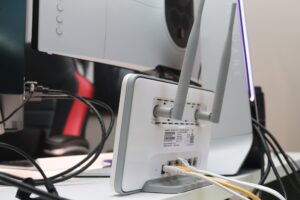
The Power of Distributed Networks: How They Can Help Businesses Stay Connected

Distributed networks are unique enough constructs that they deserve some focused attention. How different is this architecture from centralized and decentralized networks? When are they used? What are their challenges and benefits?
In this post, we’ll answer those questions and discuss how to best optimize distributed networks.
What are distributed networks?
A distributed network is defined as a collection of interconnected but independently run computer networks that are often spread across multiple geographic locations.
A few examples of distributed networks include:
- Corporate branch offices: many individual offices run on their own network, but are connected to a corporate Wide Area Network (WAN) for centralized management and monitoring.
- IoT deployments: IoT devices used to monitor and evaluate performance across buildings, warehouses, or campuses can connect to different, strategically located edge computing devices on different networks. These devices then ensure only relevant data is sent to a central device or application, rather than every IoT device sending and receiving data from one primary network.
What are some alternatives to distributed networks?
There are two main alternatives to distributed networks: centralized and decentralized networks.
Distributed network vs. centralized networks
In a centralized network, everything depends on one server or set of servers. If those servers go down, the entire network goes down.
In comparison, a distributed network is, in essence, multiple centralized networks that each have one connection to a primary server, but not every server connects to the primary. If the primary server fails, each distributed network can continue to work, although there might be some delays or disruption. The converse is also true: if one of the distributed networks fails, every other network, including the primary, can continue to operate.
Distributed network vs. decentralized networks
In a decentralized network there is no central control system present but neither does each network system operate independently. Instead, networks operate within a mesh design. Each network within the overall architecture provides certain services and data, but no network provides everything that is needed for complete operations. They all depend on one another.
What are the benefits of distributed networks?
Distributed networks are used by enterprises because they have the following benefits:
- Improved reliability
With multiple networks, mission-critical applications can continue working, at least for some sites, even in the event of a major network disruption or server outage.
Every network can add or remove infrastructure as fits its independent needs. In a day and age where remote work and other rapid business shifts are commonplace, this scalability is an important option.
- Security
In a distributed network, all secure data – whether personally identifiable information, proprietary data, or anything else that must be kept confidential – stays on its own network unless it needs to be shared. There is no automatic sharing across a centralized network. Anything that minimizes the transfer and sharing of sensitive data improves security.
- The ability to share resources and data
Since the networks are interconnected, users can share resources and data as-needed. This includes not only the ability for each independent network to share with any other network, but also the ability to push out universal network and security policies from the central network to all other networks.
What are the disadvantages of distributed networks?
These networks do have their own challenges and disadvantages. This includes:
- Migration costs
If a network is centralized or decentralized rather than distributed, there will be a significant investment required to transition to a distributed network. This is why, as with any change, performing a cost-benefit analysis is an important first step.
- Varying requirements
With each network in the system consisting of unique devices, infrastructure, and software, it can be difficult to hire IT professionals with the various skills and knowledge required. This is especially true if teams are responsible for more than one location.
- Isolation vs. visibility
It can be challenging to balance the need for each network to remain independent, but also visible to any IT professionals or administrators that require access, regardless of where those professionals are geographically located.
How can distributed networks be optimized for performance?
No matter what type of network they are responsible for, IT professionals require the same elements in order to maintain optimal performance and behavior:
- Complete visibility
There can be no network mysteries. IT teams must know exactly what devices are connected to the network, what is causing or could cause interference, and how the network is utilized. In distributed systems, this visibility would be needed for the central network as well as for whichever independent network IT professionals oversee.
- Remote troubleshooting
Optimization is best achieved if IT is not required to travel onsite to resolve issues. Remote access and troubleshooting should be commonplace so that travel is significantly decreased. If employees have to wait anywhere from hours to days for IT and network professionals to arrive before problems can be resolved, productivity will suffer.
- Real-time and historical analytics
Real-time analytics are necessary so that IT can resolve problems as soon as they occur, ideally before user experience suffers. Historical analytics ensure that teams have insight into long-term performance trends. These trends might not be obvious if teams only have access to real-time analytics that view events as isolated rather than as part of a network’s overall health history.
If IT and network professionals are supported with these capabilities, they can proactively ensure that networks are future-proofed and reliable at all times.
Optimization with the Wireless Intelligence Platform™
Whatever network you work with and/or are responsible for, Wyebot’s Wireless Intelligence Platform (WIP) can help reduce WiFi issues and future-proof network performance.
WIP analyzes all data from the entire network ecosystem using a unique combination of on-premise sensor hardware and cloud-based patented software. We use advanced wireless optimization algorithms and next-generation predictive analytics to keep WiFi networks running reliably and efficiently.
Thanks to our vendor-agnostic design, WIP will support all WiFi-dependent businesses no matter how network design changes from site to site or year to year. Enterprises that use WIP experience:
- 90% faster Mean-Time-to-Resolution
- 70% fewer WiFi problem tickets
- 80% fewer remote site visits
Ask about a demo or free trial today.


